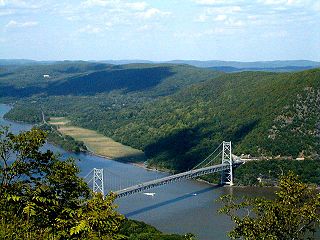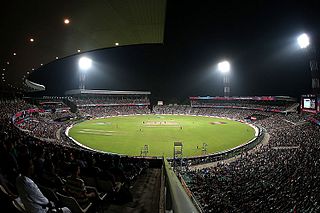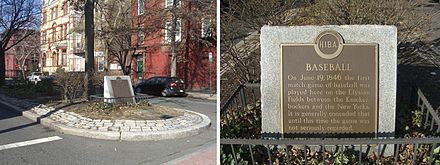
Alexander ″Alick″ Joy Cartwright Jr. was a founding member of the New York Knickerbockers Base Ball Club in the 1840s. Although he was an inductee of the Baseball Hall of Fame and he was sometimes referred to as a "father of baseball," the importance of his role in the development of the game has been disputed.
"The Mighty Casey" is episode thirty-five of the American television anthology series The Twilight Zone. Its title is a reference to the baseball poem "Casey at the Bat". It originally aired on June 17, 1960 on CBS.
1845 in sports describes the year's events in world sport.

The Polo Grounds was the name of three stadiums in Upper Manhattan, New York City, used mainly for professional baseball and American football from 1880 through 1963. As the name suggests, the original Polo Grounds, opened in 1876 and demolished in 1889, was built for the sport of polo. Bound on the south and north by 110th and 112th Streets and on the east and west by Fifth and Sixth (Lenox) Avenues, just north of Central Park, it was converted to a baseball stadium when leased by the New York Metropolitans in 1880. The third Polo Grounds, built in 1890 and renovated after a fire in 1911, is the one generally indicated when the Polo Grounds is referenced. It was located in Coogan's Hollow and was noted for its distinctive bathtub shape, very short distances to the left and right field walls, and an unusually deep center field.
The question of the origins of baseball has been the subject of debate and controversy for more than a century. Baseball and the other modern bat, ball, and running games, cricket and rounders, were developed from folk games in early Britain and Continental Europe. Early forms of baseball had a number of names, including "base ball", "goal ball", "round ball", "fetch-catch", "stool ball", and, simply, "base". In at least one version of the game, teams pitched to themselves, runners went around the bases in the opposite direction of today's game, and players could be put out by being hit with the ball. Just as now, in some versions a batter was called out after three strikes.
The Cincinnati Red Stockings of 1869 were baseball's first openly all-professional team, with ten salaried players. The Cincinnati Base Ball Club formed in 1866 and fielded competitive teams in the National Association of Base Ball Players (NABBP) 1867–1870, a time of a transition that ambitious Cincinnati, Ohio businessmen and English-born ballplayer Harry Wright shaped as much as anyone. Major League Baseball recognized those events officially by sponsoring a centennial of professional baseball in 1969.

Metropolitan Club was a 19th-century professional baseball team that played in New York City from 1880 to 1887.
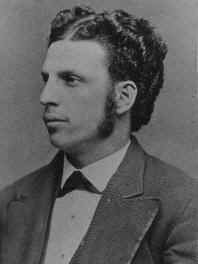
George Wright was an American shortstop in professional baseball. He played for the 1869 Cincinnati Red Stockings, the first fully professional team, when he was the game's best player. He then played for the Boston Red Stockings, helping the team win six league championships from 1871 to 1878. His older brother Harry Wright managed both Red Stockings teams and made George his cornerstone. George was elected to the Baseball Hall of Fame in 1937. After arriving in Boston, he also entered the sporting goods business. There he continued in the industry, assisting in the development of golf.

The St George's Cricket Club was located in Manhattan, New York. It hosted the first international cricket match in 1844, between Canada and the United States. The club was founded in 1838. Nicknamed the Dragonslayers for their domination of local cricket opposition, the SGCC set the standard of US cricket from 1838 to the Civil War.
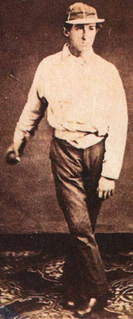
James Creighton, Jr. was an American baseball player during the game's amateur era, and is considered by historians to be its first superstar. In 1860 and 1862 he played for one of the most dominant teams of the era, the Excelsior of Brooklyn. He also was reputed to be a superb cricketeer, and played in many amateur and professional cricket matches.
Union Grounds was a baseball park located in the Williamsburg section of Brooklyn, New York. The grounds opened in 1862, its inaugural match being played on May 15. It was the first baseball park enclosed entirely by a fence, thereby allowing proprietor William Cammeyer or his tenant to charge admission. This permitted paying customers to watch the games from benches in a stand while non-paying spectators could only watch from embankments outside the grounds.
The National Association of Base Ball Players (NABBP) was the first organization governing American baseball. The first convention of sixteen New York City area clubs in 1857 practically terminated the Knickerbocker era, when that club privately deliberated on the rules of the game. The last convention, with hundreds of members represented only via state associations, provoked the establishment of separate professional and amateur associations in 1871. The succeeding National Association of Professional Base Ball Players is considered the first professional sports league; through 1875 it governed professional baseball and practically set playing rules for all. Because the amateur successor never attracted many members and it convened only a few times, the NABBP is sometimes called "the amateur Association" in contrast to its professional successor.

The Capitoline Grounds, also known as Capitoline Skating Lake and Base Ball Ground, was a baseball park located in Brooklyn, New York from 1864 to 1880. It was built to rival nearby Union Grounds, also in Brooklyn. The park hosted local amateur teams in its early history, but later hosted professional and semi-professional games. The park's only season as the home field for an all-professional team occurred in 1872 when the Brooklyn Atlantics joined the National Association of Professional Base Ball Players. The park was flooded during the winter and used as an ice skating park. The grounds were used by local high schools and colleges as well, to play American football games, and ice rink football matches.
Oakland Park was a ballpark in Jersey City, New Jersey. It was used by the New York Giants for their first two home games in 1889. The park was opened in the spring of 1888, as the new home of the Jersey City minor league club Jersey City Skeeters. The Jersey City club disbanded in July 1890, but the park continued to be used by other local teams for several years.
The following are the baseball events of the years 1845 to 1868 throughout the world.
Eckford of Brooklyn, or simply Eckford, was an American baseball club from 1855 to 1872. When the Union Grounds opened on May 15, 1862 for baseball in Williamsburg, Brooklyn, it became the first enclosed baseball grounds in America. Three clubs called the field on the corner of Marcy Avenue and Rutledge Street home; however, the Eckford of Brooklyn were the most famous tenant. They played more games than any other club that year (7) and won the "national" championship, repeating the feat in 1863. During that two year period, the Eckfords won 22 straight matches which was the longest undefeated and untied streak to date. In the late 1860s, they were one of the pioneering professional clubs, although probably second to Mutual of New York at the home park. In its final season, Eckford entered the second championship of the National Association, the first professional baseball league in America, so it is considered a major league club by those who count the NA as a major league.
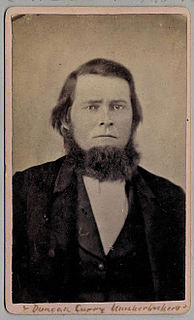
Duncan Fraser Curry was an American baseball pioneer and insurance executive.




